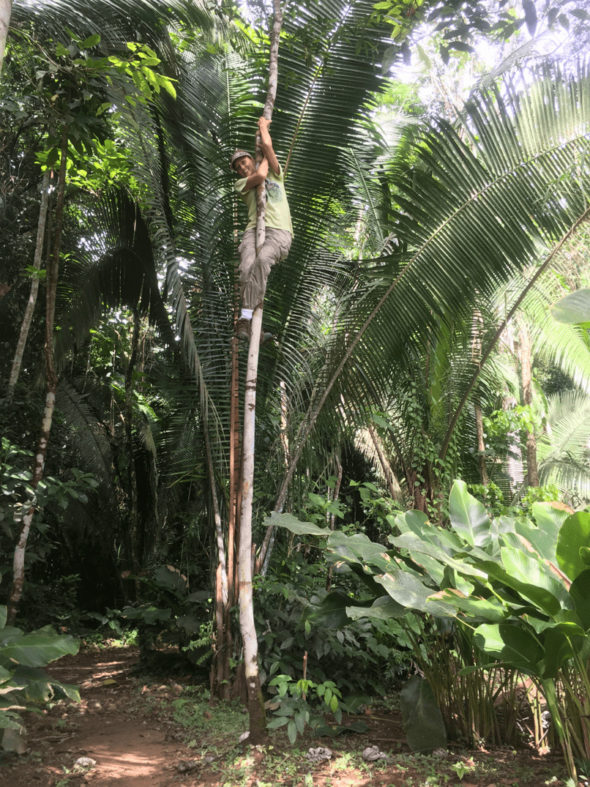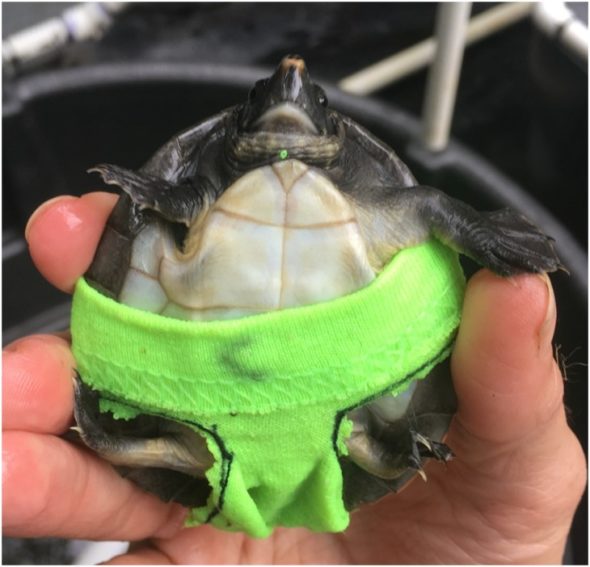By Danielle Filjon
Upon her arrival in Belize, Dr. Bishop asked locals for any information about the anatomy, breeding habits, or food preferences for the species, but was instead given “dozens of recipes of how to best prepare Hicatee.”
Deep within the Belizean jungle, far from the reaches of humanity, exists a species of turtle whose future hangs in the balance between human impact and threat of extinction.
The Hicatee turtle (Dermatemys mawii) is a freshwater turtle native to Mexico, Guatemala and Belize. According to the Turtle Survival Alliance, “the Hicatee turtle is the only living species in an ancient family dating back 65 million years, it is so resilient that it has outlived the dinosaurs.”
The Hicatee, pictured below, is seen as a cultural staple for festive meals (much like Turkey during Thanksgiving in the United States), and has been over-hunted to the point of critical endangerment. The Hicatee is the national reptile of Belize, a cultural pillar that has been tradition for generations, a species that has been thriving for eons, and it is at the risk of being gone forever. Flagler College professor of Environmental Science Dr. Nicole Bishop set out to try and mitigate the loss of this important species between 2015-2019.
Dr. Bishop is an adjunct professor of Environmental Science at Flagler, but she a full-time professor at University of North Florida. Her interest in conservation science originated from her curiosity for the natural world as a child.
“I always wanted to be that scientist who goes out and does super meaningful research, and then I became that,” Dr. Bishop said. “8-year-old me would be so proud of me today.”
The Hicatee turtle piqued her interest for the very reason of their importance in Belize; not only for the environment, but for cultural significance as well. These turtles have no other external environmental threats– their natural habitat is very well protected by the Belizeans. However, Dr. Bishop has found that “harvesting Hicatee is so ingrained in Belizean culture,” so getting the message of human impact on this species was challenging.
Dr. Bishop was essentially the pioneer of all knowledge about Hicatee turtles. Before her research began in 2015, not much was known about the species: what they ate, their anatomy or breeding patterns. Local Belizeans also don’t often venture as deep into the jungle as Dr. Bishop and her team, so the trailblazing scientists had an open playground to discover.

Nestled in nearly 3.5 million acres of wilderness, Dr. Bishop and a team of researchers worked with the Turtle Survival Alliance at a solar-powered off-grid field station. Her team, made up of scientists from abroad as well as locals, were able to piece together this puzzle of information about this species previously lost to the scientific community in Belize.
“But it’s not like [scientists in Belize] didn’t have an interest or technology for researching Hicatee, they just didn’t see it as being necessary,” Dr. Bishop said.
But the study and conservation of this turtle is absolutely necessary. People won’t be inclined to conserve what they are not familiar with. “Do you think people would be faster to conserve the African elephant or a more obscure species? People conserve what they know and have learned about,” said Bishop. The hundreds and hundreds of endangered species around the world could be conserved through better research and informing society of their importance.
This is why research like Dr. Bishop’s is so crucial. A matter of an entire species’ footprint on our planet being erased is a story that is repeated with many species around the world, not just Hicatee. Learning about, informing, and conserving our world’s animals is the kind of stewardship that we should be encouraging. Dr. Bishop’s work is a shining example of what could be done for many other species and ecosystems globally.

Dr. Bishop in the forest near the field research station, where her and the team had to hike 6 miles inland to reach on every trip.
In their years of work at the station, Dr. Bishop and her team discovered that Hicatee, despite being herbivorous at hatch, grow faster than turtles who are carnivorous at hatch. They also did extensive microbiological research on Hicatee’s nutritional ecology– how they process nutrients. One of the ways the researchers were able to research Hicatee digestion was attributed to Dr. Bishop’s handmade “diapers” for both baby turtles and adults to collect fecal matter to be analyzed.

“I don’t think people recognize how important creativity is to understanding science” Dr. Bishop’s handmade “turtle diapers” for baby Hicatee are certainly evidence of that.
After her years of learning about and researching Hicatee, Dr. Bishop’s hope is that more energy can be put into their conservation in Belize.
“As an outcome of my research, I hope that regulations that protect Hicatee will change to become based in science, instead of their limited protection as of now, and take into consideration scientific data about them, such as breeding patterns regulating when they can and cannot be hunted,” Bishop said.
The good news is, after many conferences and outreach programs, local Belizeans have been more open to conserve and educate other locals about the Hicatee and about dangers of overhunting, what Dr. Bishop called “a synthesis between science and culture.”
If you are interested in seeing a Hicatee for yourself, Dr. Bishop recommends visiting Jacksonville Zoo, which has a small population of them and pours a lot of money into conservation work.
“Support the Hicatee by buying an admission ticket, that money goes into a lot of conservation research,” Dr. Bishop said. “That goes for any species, you can help by visiting an accredited and sustainable zoo for your money to go towards research.”
Turtle Survival Alliance, the program that sponsored and conducted this research, also takes donations on their website turtlesurvival.org. They do work with many different turtle species, and are still impacting communities and ecosystems all over the world with their groundbreaking research.
As far as the future of the Hicatee, Dr. Bishop is optimistic.
“These efforts are a big step forward,” Bishop said.
Not only in Hicatee conservation, but in species research and conservation as a whole. Dr. Bishop and her team were advocates for this species, and pioneers in environmental research and conservation where the “main animal involved in conservation is people.”
You can follow Dr. Bishop and her turtle adventures on Instagram @relientUK.
Linked below, is a short documentary made about this Hicatee research done in Belize made by the Turtle Survival Alliance. https://youtu.be/b6SIwu1X6ZI
Photos courtesy of Dr. Nicole Bishop




Be the first to comment on "Turtles in the Jungle: A Flagler Professor’s Conservation Story"